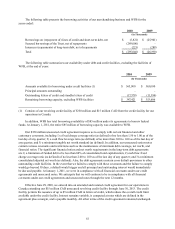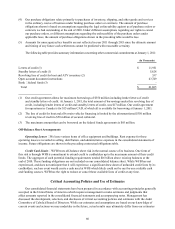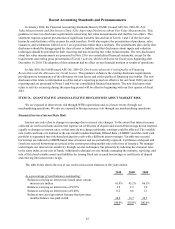Cabela's 2010 Annual Report Download - page 72
Download and view the complete annual report
Please find page 72 of the 2010 Cabela's annual report below. You can navigate through the pages in the report by either clicking on the pages listed below, or by using the keyword search tool below to find specific information within the annual report.62
Catalog Costs
Deferred catalog costs consist of incremental internal and third-party direct costs incurred in the
development, production, and circulation of our direct mail catalogs, composed principally of creative design,
prepress/production, paper, printing, postal, and mailing costs. Deferred catalog costs are amortized over their
expected period of future benefit or twelve months, whichever is shorter, based upon sales forecasts developed
using historical sales for similar catalog offerings. Deferred catalog expenses are evaluated for recoverability at
each reporting period by comparing the carrying amount associated with each catalog to actual sales data and to
projected future cash flows. Had our amortization estimate of deferred catalog costs been different by 10% for
2010, our catalog costs expense would have been higher or lower by approximately $1.9 million.
Long-Lived Assets
Long-lived assets other than goodwill and other intangible assets, which generally are tested separately for
impairment on an annual basis, are evaluated for impairment whenever events or changes in circumstances indicate
that the carrying value may not be recoverable. When we evaluate long-lived assets for potential impairment,
we first compare the carrying value of the asset to that asset’s estimated future undiscounted cash flows. If the
estimated future cash flows are less than the carrying value of the asset, we then calculate an impairment loss.
The calculation for an impairment loss compares the carrying value of the asset to that asset’s estimated fair
value, which may be based on estimated future discounted cash flows or quoted market prices. We recognize an
impairment loss if the asset’s carrying value exceeds its estimated fair value. If we recognize an impairment loss,
the newly adjusted carrying amount of the asset becomes its new basis. For a depreciable long-lived asset, the new
cost basis will be depreciated over its remaining useful life. Frequently our impairment loss calculations contain
multiple uncertainties because they require management to make assumptions and to apply judgment to estimate
future cash flows and asset fair values, including forecasting cash flows under different scenarios, determining
a discount rate that reflects the risk inherent in future cash flows, and incorporating financial data from other
parties. We have consistently applied our accounting methodologies that we use to assess impairment loss.
However, if actual results are not consistent with our estimates and assumptions used in estimating future cash
flows and asset fair values, we may be exposed to losses that could be material.
Economic Development Bonds
We recognize economic development bond investments based on estimates of the discounted future cash
payments to be received under these bonds. These estimates are also the basis for our recognition of deferred
grant revenue to be received under the economic development grants as an offset to construction costs which is
amortized over the asset lives of the development. These cash flow estimates are dependent on property and/or
sales tax collections derived from our operations, and potentially other businesses, some of which may be in the
development stage. Had our fair value estimates been lower by 10% as of the end of 2010, the value of economic
development bonds reflected in our consolidated financial statements would have been approximately $10 million
less with the unrealized loss reflected in comprehensive income (loss) if the loss was deemed to be temporary. Any
declines in the fair value of held-to-maturity and available-for-sale economic development bonds below cost that
are deemed to be other than temporary are reflected in earnings as realized losses. Gains and losses on sales are
recorded on the trade date and determined using the specific identification method.
























